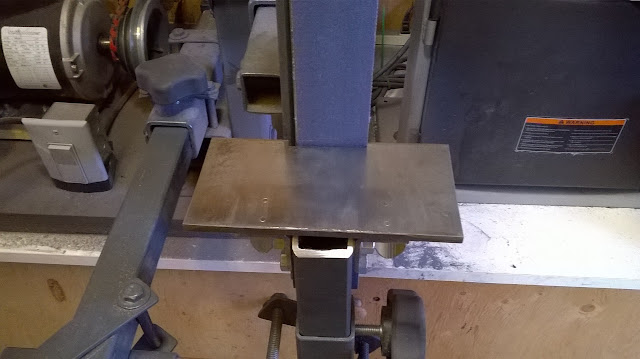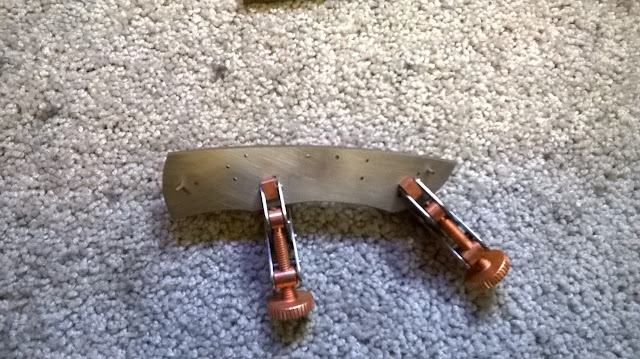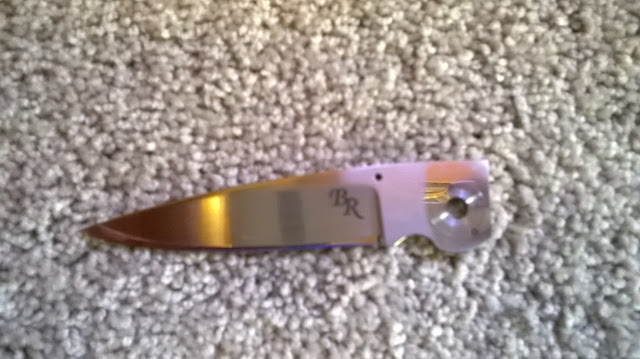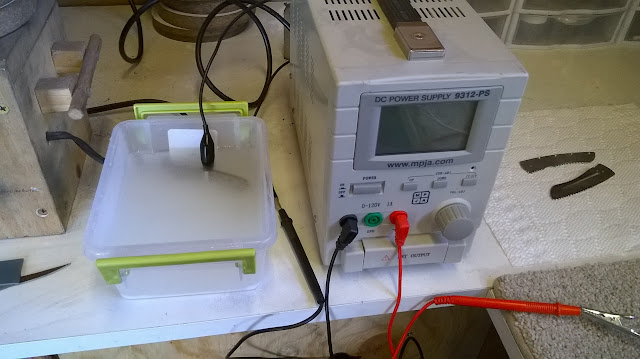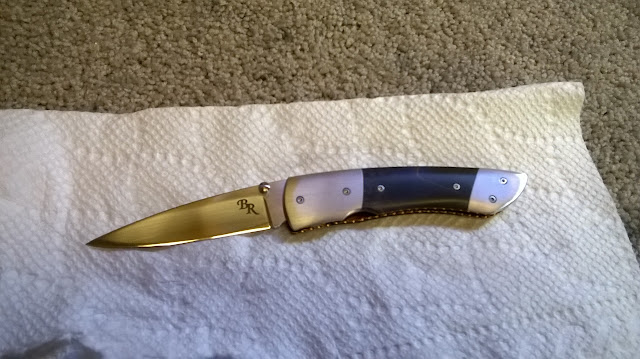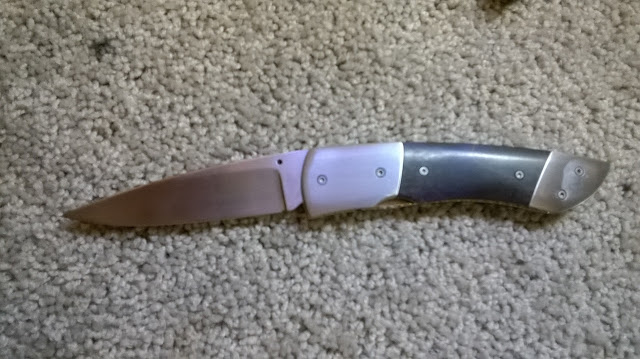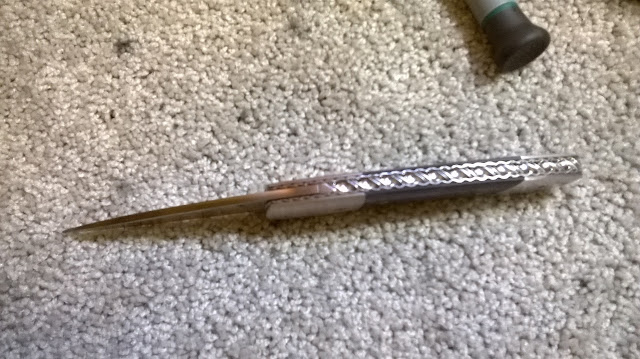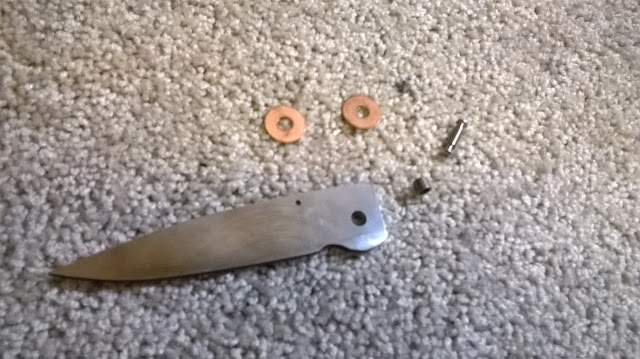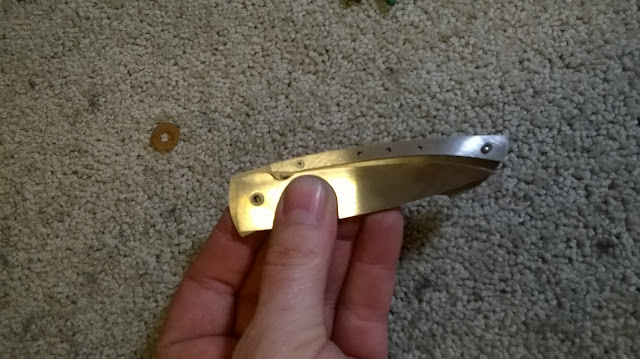For those of you who like to read, I thought it would be fun
to address here on the Robinson Edge a few of the most frequently questions
that I get asked about my knives and knife making in general. I have no doubt that those of you who make
knives get asked many of these same questions, so they really aren’t unique to
me, but I thought it would be entertaining and maybe informative to post them
here. Maybe I’ll even start a new page
for reference.
Question: Where do you get your blades?
Answer: This is probably the most frequently asked
question that I get about my knives, and possibly the most amusing to answer. I think many people out there are familiar
with “kit” knives that one can purchase which are essentially finished knives
that just need to be assembled and maybe some light sanding and finish work. You should see people’s faces as I tell them
that I make my blades. I usually get
that “I don’t believe you” look in return.
I guess many people don’t believe that someone can make a knife in a
home shop. Depending on how truly
interested they are in knowing the full answer to this question, I may go into
detail to explain how I make all of my blades, and other parts for that matter,
from bars of raw steel. I may delve into
steel choices, blade design, heat treatment procedures, and a myriad of other topics
regarding knife blades. Or, if they
really don’t want to know the whole answer to their question, I may just say a
simple, “Yup, I make them.”
Question: Why do your knives cost so much?
Answer: This is always the hardest question to
answer since you are either familiar with custom handmade knives or you aren’t. Some people don’t see much point in spending a
lot of money on something they can pick up at Wally World for twenty
bucks. Let’s face it, if all you want is
a tool to pick out splinters, clean your fingernails, or open you mail, then a
$20.00 production knife might be the right choice. If you’re looking for a unique, one-of-a-kind
piece of edged art that can be handed down to your grandchildren as an heirloom,
then a hand-made knife is the only way to go.
I have come up with two analogies that help explain what a custom knife
is in comparison to a production knife from the hardware store.
The first analogy is to compare a knife to a car. You can purchase an old, used and abused
truck from an old farmer for a few hundred bucks, or you can buy a new car off
the lot for tens of thousands. You can even
take this analogy a step further and buy a custom-made car for hundreds of
thousands of dollars from a well-known, well-respected shop. So why by the new car or more specifically
why buy the custom made sports car? For
someone simply looking to get from point A to point B, the old truck will get
the job done. The gears may grind, the
steering may wander a bit, the passenger side window might not go down all the
way, and there may be an odor that emanates from the back seat that won’t go away
no matter how much air freshener you spray, but it will get you home in one
piece; a little frazzled albeit, but still in one piece. The new car off the lot steers perfectly,
everything operates and functions as designed, and it comes with that new car
smell. But, still, it looks just like
that car the neighbor across the street uses to drive her kids to soccer
practice. It might be a different color,
but it’s still the same car. Now, for
those true car lovers, the few who have the means and the wherewithal, the
custom car comes with prestige, assurance that only the finest materials and
craftsmanship were used, it’s the only one in town like it, and that feeling
that you get as you are forced back into your seat when you romp on the
throttle is priceless.
The second analogy I use is to compare a knife to a
quilt. You can go to Wally World and
purchase a blanket off the shelf for twenty or thirty bucks or you can purchase
a handmade quilt from an experienced quilter for hundreds or even thousands of
dollars. Both quilts will cover your bed
and keep you warm at night. The difference
lies in the materials, time, and craftsmanship that went into the
production. The Wally World blanket was
made with the cheapest materials, by unskilled labor somewhere overseas and
treated as just another commodity. The
handmade quilt is made with the very finest textiles, cut and fit in the most
intricate and artistic of patterns by hands that are full of experience, wisdom
and care. The first, you get a blanket,
the second, a true piece of art.
It’s all about what you want out of a knife. If you want something truly unique, handcrafted
out of the finest materials in the most caring of ways by hands that are
attached to a true artisan, you want a handmade, custom knife. If you want something to open your UPS
package, a sharpened piece of rebar will do.
It’s all about the value you place on the item.
Whew! That was a long
answer.
Question: Why do your knives cost so little?
Answer: I don’t get this question near as much as
the one above, but it certainly bears mentioning. For those people who are familiar with the
world of custom knives, to them my prices seem incredibly low relative to other
makers out there. There are a couple of
reasons that I attribute my low prices to, the first of which is that I am a
relatively new maker. I assume that the
more exposure my knives get, the higher the prices will go. A few years from now my prices may be two or
three times what they are now as my name becomes more recognizable and the
resale value of my knives climbs. The
second reason my prices are so low is the simple fact that I love to make
knives. I make them as a fun hobby and
not as a business hoping to get rich someday.
My goals are to clear actual materials cost and make enough per knife to
buy materials to make the next one and keep my tools in good repair, and maybe
buy enough soda to keep me hydrated while out in the shop. I will say that if at any time you want to
purchase one of my knives for a higher price that I have it listed for, please
let me know. I’d be more than happy to
negotiate (wink, wink).
Question: What are those scales made out of?
Answer: This question obviously varies with each
knife and how flamboyant and colorful, or simple and elegant the material used
may be. I use mostly natural materials
for the scales on my knives, but I also use a little of the manmade stuff. I use a lot of wood, some mammoth ivory and
tooth, mother of pearl, as well as horn and antler. Much of the wood I use is professionally stabilized
which makes it resistant to cracking, moving, and less prone to problems when exposed
to water. The only synthetic material
that I have used so far is Micarta (phenolic resin material). It’s a good choice for a knife that is used
around a lot of water since this stuff is hydrophobic and doesn’t swell or
shrink; it’s nice and stable. I don’t
like most synthetic materials since they tend to look a little gaudy and far too
much like plastic (since they are plastic).
I heard it said once referring to a plastic material as “Mother of
toilet seat.” That name and descriptive
language conjures up quite the image in my mind and has stuck with me since I
first heard it. It’s just a personal
preference I guess, but I don’t use much beyond the simple colors of Micarta
when it comes to manmade materials.
Question: What kind of tools do you use?
Answer: I think people expect me to tell them of
all the highly automated, highly specialized and expensive equipment that I
have in my shop. If you’ve taken the
time to visit my “Shop Tour” page here on the Robinson Edge, you will see that
I have none of that stuff in my little converted garden shed I call my
shop. My tools are very basic, tools
that most do-it-yourselfers would have in their garage already. All of my larger tools are small
bench-mounted versions of a drill press, band saw, buffer, disc grinder, mini
wood lathe, and the two specialized pieces of equipment, my belt grinder and
heat treat oven. I also use a small bunch
of hand tools such as files, a rotary tool, taps, reamers, clamps, and a few
others. It really doesn’t take a lot of
specialty tools to make a good knife, just a few basic ones. I admit that if I was making knives as a
business and looking to make a large profit, my tooling would be much
different, but for my hobby shop, I’ve got all that I need.
That’s enough Q&A for now. Like I said before, I may add a dedicated FAQ
page here on my blog just for kicks and giggles. I hope I haven’t bored you to death with my ramblings,
but if you’re reading this, the last paragraph of this post, you must have
muddled through alright. I hope this has
been entertaining and maybe even informative.
Thanks for stopping by the Robinson Edge.
- Brandant Robinson


